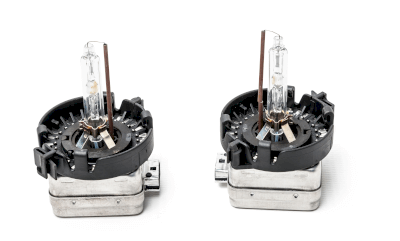What Is a HID Lamp?

HID (High Intensity Discharge ) Lamps are lamps intensity discharge lamps characterized by high luminance, low power consumption, and long life.
A vapor of rare gases and metal atoms is enclosed in a glass tube, and the lamp emits light when an arc discharge occurs. Depending on the metal atom gas, there are mercury lamps, high-pressure sodium lamps, and metal halide lamps.
They emit blue-white to white light immediately after lighting, and the color of the luminescence stabilizes over a period of about ten seconds.
Uses of HID Lamps
HID Lamps are used in streetlights, gymnasiums, warehouses, stadiums, plant growth rooms, and other situations requiring illumination that require high intensity visible light.
They are also incorporated into car headlights because of their ability to illuminate brightly and far, and are useful for increasing safety when driving on dark roads such as highways and mountain roads. When used in car lights, they are also called xenon lights or discharge lamps.
They are also used to illuminate advertisements and billboards to make them stand out. In addition to visible light illumination, by extracting ultraviolet light, they are sometimes used as lamps for ultraviolet irradiation, and can be applied to sterilization, cleaning, and surface modification by ultraviolet light.
Principle of HID Lamps
HID Lamps emit light by using high voltage electrical energy to create an arc discharge in a gas. When a gas is enclosed in a light-emitting tube and an electrical discharge is generated inside, various types of light emissions are produced depending on the type of gas, voltage, and other conditions.
Ceramic or quartz glass is used as the material of the light-emitting tube. Two opposing electrodes are installed inside the light-emitting tube, and the electrodes are heated by passing an electric current through them. At this time, thermal electrons are emitted from the electrode surfaces. The electrons go to the counter electrodes and collide with metal atoms enclosed in the light-emitting tube, emitting visible light.
HID Lamps have the highest efficiency, followed by metal halide lamps and mercury lamps. High-pressure sodium lamps emit orange-white light, while metal halide and mercury vapor lamps emit white light.
A device called a ballast converts AC power to DC and outputs a stable voltage to maintain the arc discharge. An igniter, a high-voltage power supply, boosts the pressure of the gas inside the lamp and causes an arc discharge.
Thus, HID lamps are equipped with a dedicated control circuit and can maintain high luminance and stable light through stable power supply and control.
Types of HID Lamps
As mentioned earlier, HID lamps include mercury lamps, high pressure sodium lamps, and metal halide lamps.
1. Mercury Lamps
Mercury lamps are brighter than incandescent lamps, have a longer life, and can achieve high luminance, which is why they are often used for streetlights and lighting in large facilities. In addition, mercury lamps are suitable for exciting luminous materials such as fluorescent substances because their spectrum is very narrow and they emit light of a certain wavelength.
2. High Pressure Sodium Lamps
High-pressure sodium lamps are characterized by the emission of orangeish white light and are mainly used for outdoor applications. High-pressure sodium lamps generate light with relatively high efficiency and are particularly good at producing white light.
3. Metal Halide Lamps
Metal halide lamps are characterized by high luminance and high light reproducibility. Several types of metal halides are used for the light-emitting tubes, which can express various color temperatures and hues. Metal halide lamps also produce more light than mercury lamps and have a higher color temperature than high-pressure sodium lamps, and are used as plant growth lighting.